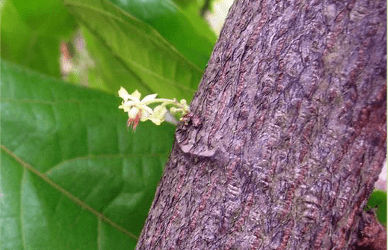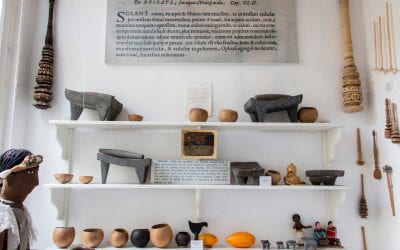Small (Labor) Truths
The Persistence of Child Slavery in Modern Cacao Production and Alternative Models

Direct trade chocolate
In 2005, a company named Taza debuted a new way to do chocolate. The disc-shaped bars produced in their Somerville, Massachusetts factory were minimally processed from from ethically-sourced cacao and contained only ingredients that might have been used by the original Aztec and Mayan cultivators, plus sugar.
However, its innovation lies not so much in the bars themselves, but in the methods it uses to procure its ingredients. This method, direct trade, was designed as an alternative to the increasingly problematic Fair Trade model; Taza deals directly with cacao-producing cooperatives in Latin America, offering three times the market value price for raw chocolate and conducting its own inspections to ensure that farmers use environmentally sustainable methods and ethical labor practices.
That same year, Theo, a Seattle-based company, became the first producer of organic bulk chocolate in the United States. It expanded to consumer chocolate bars the following year. While its bars looks and tastes more like the Dutch-processed chocolate we have come to expect, the company also acquires its raw materials through direct-trade with the Peruvian cooperative that grows some of the other ingredients Theo uses in its chocolate.
Across the Atlantic ocean, Tony’s Chocolonely formed in 2005 when journalists purchased a cacao plantation in Ghana and gave its workers complete control over production, effectively creating a direct-trade relationship and a co-op simultaneously. These companies reacted in similar ways to news that the government watchdogs and corporate entities who govern cacao cultivation had failed to eliminate persistent use of child labor (called “small labor”) and child slave labor in cacao production. They each set out to prove that humane business practices could eradicate the worst forms of labor malpractice and child abuse in one of the most lucrative agro-business industries in the world, one which generates more than $100 billion in revenue every year.
Direct trade proponents strive to raise consumer awareness about the ethics of chocolate production, the limitations of a corporatized Fair Trade system and the rights of farmers to a living wage. Thanks to complicated hierarchies and an expensive certification process, the touted Fair Trade standard on which so much agricultural trade is based has proven insufficient to elevate cacao farmers (or anyone else) out of poverty. In order to produce a truly ethical chocolate, manufacturers largely returned to cacao’s origins in terms of region, cultivators and labor model.
Chocolate School
Aztec royal and military classes consumed cacao primarily as a savory beverage, while laboring classes cultivated it and used its beans to pay yearly tribute to the upper classes. Spanish colonists inherited Aztec trade and tribute systems when they invaded the region in 1519-20, and missionaries introduced slavery into cacao cultivation by forcing Indians to labor for their salvation. Most of them died, so the Spanish began importing African slaves in the 1600s. By the time slavery was abolished in Brazil in 1888, Africans in America had become well-versed in cacao production.
Perhaps this is why the British felt confident they could introduce theobrama cacao into west African agriculture in the 1860s. Within a few short decades, the supply of African cacao had eclipsed its Latin American ancestor even as demand for chocolate grew exponentially. In 1895, Latin American farms still provided the largest portion of the world’s cacao, contributing 77,000 metric tons; in 1925, West African farms produced 500,000 metric tons of cacao beans, capturing the supply market while overseeing an exponential growth in consumer demand.

Tropical belt cacao map
Though cacao is not a plantation crop per se—its production model typically consists of a loose organization of small farms rather than one large farm spanning hundreds of acres—it is labor intensive. Cacao pods must be harvested by hand using machetes to cut the pods from trees and again to break open the pods to separate the beans. Additionally, theobrama cacao grows only within a narrow band of latitude in tropical regions; each cacao tree takes five years to mature, requires plenty of water, and grows best amid old-growth trees in rainforests. Cacao production waned in Latin American agriculture not only because slavery had declined, but because agriculture itself became more mechanized, and soil depletion caused by plantation and plantation-like farming methods led to deforestation in areas where cacao formerly grew. Demand for other tropical produce skyrocketed around the world, and the United States colonized parts of Latin America in order to ensure easy access to these goods. It replaced slavery with debt-peonage, and reconstructed its large-scale plantation model in warmer climes, using essentially the same (newly-emancipated) workforce.
Meanwhile, in Africa, chocolate was good business in the first half of the last century. The newly independent West African nations of Ghana and Cote d’Ivoire built their fledgling economies on the promising crop, and taxed farmers harshly while limiting cacao prices internally in order to sell cacao at stock-market value while paying pennies on the dollar at the farm-gate. Within two decades, both Ghana and Cote d’Ivoire were impoverished nations, even as the market expanded and prices increased over the remainder of the century. Faced with crushing debt, farmers planted more cacao, sometimes invading protected forests to do so. Facing labor shortages, diminishing resources, and failing profits, cacao farmers made the next, inevitable leap in nightmare logic: they began resorting to child labor to fill these gaps.
Co-op Blues
Human rights workers estimate that more than two million children, many of them slaves, work on African cacao farms. Enslaved children sometimes work alongside “small laborers,” members of the farm owner’s family or legitimate wage earners who provide a sort of protective coloration for the slaves against the prying eyes of investigative journalists or aid workers. The strategy has been only partially successful: In 2001, and again in 2011, BBC reporters exposed the practice of child labor and child slave labor in African chocolate production. After the 2001 exposé, two U.S. congressmen crafted the Harkin-Engel Protocol, designed to raise farm-gate prices and eradicate child labor in cacao production by 2005. All major chocolate manufacturers agreed to work with member farmers to set fair, above-market prices, monitor farmers’ labor systems, and penalize transgressors.

Child laborer with African cacao
Structurally, this new model resembled the existing, and often successful, cooperative system in Latin American textile manufacture and agricultural production. The United States’ heavy-handed neocolonialism sparked a series of violent protests and revolution across much of the region, and where possible, workers took control of certain means of production and redesigned those models based on 20th-century socialist/communist philosophies or ancient indigenous practices, depending on whom one asks. Unfortunately, the African cooperative system was never intended to function like Latin American ones, in which like-minded producers bargain collectively from a place of strength. Since African farmers have borne sole blame for modern slavery, chocolate manufacturers serve more like enforcers in the African cooperatives, working above farmers and intermediary buyers. Needless to say, the balance of power tilts sharply in the corporations’ favor. Cacao farmers remain at the bottom of the pyramid, victims of a pricing scheme over which they have no control, forced to sell their crops for a little more than US$1 per kilo—beans that more than double in value after repackaging in a corporate warehouse, and whose price increases exponentially once sold by the parent corporations to individual manufacturers on the open market. The chocolate manufacturers seemed resigned to failure, quietly extending the Protocol’s 2005 deadline to 2008, then 2011, and again to 2020. Each extension accompanied a disappointing revelation in the industry. Not only has forced child labor persisted in cacao production in Africa, a 2015 Fortune article, later corroborated by a report from the USDA, found that use of slaves has actually increased.
Unfair and unequal labor practices have defined chocolate from its Meso-American roots through its gradual globalization, so it is somewhat ironic that slavery’s absence in modern Latin American cacao production is a direct result of its continued presence in Africa. Independent chocolate manufacturers in Europe and the United States examined the situation uncovered in west Africa and decided to create alternative sources for cacao free from the inequities of the labor and market systems which have defined its production. Since Latin America already possessed the infrastructure and climate to sustain cacao cultivation, conscientious chocolate manufacturers could focus their attention on the labor concerns, which could largely be solved by truly addressing pricing, income and environmental issues.
(New) Chocolate Rules
In 2019, Taza paid about $3,100 per metric ton for the beans, which were cleaned and fermented locally before being shipped to the company factory in Somerville. Taza sells its 1.75-ounce chocolate discs in packages of two for about US$5, earning more than $70,000 from every metric ton of chocolate used. The company draws from collectives in countries across Latin America and the Caribbean such as the Dominican Republic, Peru, and Haiti; in addition to paying the collectives well, its owners directly monitor the labor practices of their members to curtail inhumane and environmentally unsustainable practices.
Fall 2020, Volume XX, Number 1

Altereco Label
Direct trade looks a lot like Fair Trade, but has so far succeeded where its corporatized ancestor has not. Just last year, Brazil found that several coffee farms had resorted to slave labor even as they were re-certified by Dutch watchdog organization UTZ. The farms involved had also been certified slave-free by CARES (a Starbucks company) and Fair Trade. So why is direct trade working where Fair Trade has failed? The revelations of Fair Trade’s shortcomings are fairly recent, so it is difficult to say, though likely tied to the financial burden Fair Trade certification places on suppliers—the very people it was designed to assist.
The distance between Fair Trade (or UTZ, or CARES) and the cooperatives is great, and filled with intermediary costs and people. Actual monitoring is sporadic, leaving abuses unchecked internally. Because direct-trade cooperatives were formed specifically to combat abusive labor practices, they are closely monitored, not by middlemen, but by manufacturers, who alone bear the costs of their efforts.

Tonys Slave Free Logo
For years, Tony’s has been the only direct-trade company to tackle the industry’s use of slave-labor at its source in Ghana. It has recently been joined by Theo, which opened another cooperative in the Democratic Republic of Congo, and Taza, which has also entered into a direct-trade agreement with a Ghanaian cooperative. Nor has the direct-trade model itself been the only response to combat bad industry labor practices. The popular German brand, Ritter Sport, decided to forego unreliable third-party verification and create its own self-contained plantation and partially-mechanized fermentation system in Nicaragua, slated to begin production in 2020. The scheme is reminiscent, in practice, of decisions made by US corporate operators in that region last century, and thus potentially worrisome. However, as long as Ritter Sport applies its strict German labor laws in Nicaragua, it could provide a tremendous growth opportunity for local farms and the region.
Information on chocolate sourcing has become more transparent in the past ten years, as more companies develop or change their models. Helpful websites like slavefreechocolate.org encourage consumers to investigate the issue and list the growing number of companies who engage in truly ethical sourcing for their cacao. Some, like Equal Exchange, who got its start in ethical coffee sourcing before branching out into chocolate in the early 2000s, are working to fix the Fair Trade certification in which they participate rather than reinvent the wheel using direct trade. One producer, Mānoa, has situated itself in the United States’ only tropical state, Hawaii (only the southern part of Florida is tropical), and “sources locally,” avoiding the Global South’s labor trap altogether. The biggest names in chocolate such as Lindt, Hershey’s, Cadbury’s and Ghiradelli do not make the list. It seems they still rely on consumers’ cravings to outweigh consumers’ morals.
Chocolate joins the ranks of textiles, diamonds and coffee in our public awareness and horror of certain industries’ unfair labor practices. While we are encouraged to be appalled by such practices, we are not encouraged to feel empowered to stop them. In absence of government action, individual companies have taken initiative to create direct-trade relationships with cacao producers and raise awareness through grassroots digital media campaigns—a non-existent option in 2001 in the wake of BBC reporting, nor in 2008 after the Protocol’s second failed deadline. If the manufacturers themselves will not adopt ethical practices, their customers must. Consumers can only continue to make the hard, but correct, choice to rely on direct-trade, single-source brands using (mostly) Latin American cacao from vetted, approved farms.
Tara M. Dixon is an independent scholar living in northern Virginia. She holds a Ph.D. in world history from Northeastern University, although her postgraduate work often lies at the intersection of commodification, culture and sustainability. She is currently working on a food history of coconuts and other tropical produce.
Related Articles
Discovering the Taste of Molecules in Chocolate
English + Español
I’m a chemist. And you generally don’t think about chemistry when you have a delicious cup of chocolate. But I have studied the chemical composition of chocolate for 20 years and I would like to share what I have learned with you. For more than three decades…
Keeping the Heritage through a Museum
English + Español
As an architect, I’ve been fascinated by museums and how the design of spaces can influence the experience of the visitor and the meaning of the objects within. Museums are not only repositories of valuable pieces preserved for posterity, but cultural elements…
Gendered Chocolate Mythologies
In 1925, the cartoon figure of a portly white gentleman was created to advertise chocolates produced by the English firm of Rowntree & Co, which by this time operated a large factory on the outskirts of the city of York. Given the name “Plain Mr. York, of…




